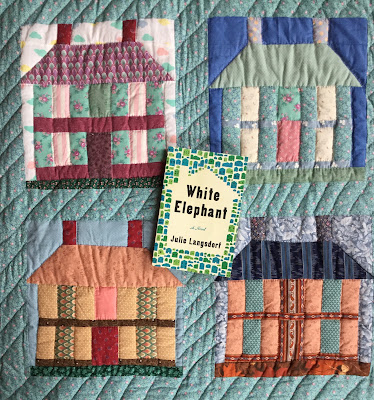 |
| Twilight Zone, Walking Distance by Rod Serling |
 |
| detail of Country Village quilt by Nancy A. Bekofske |
It reminds me of places I have lived in, like the small city that banned fast food chains. Or the even smaller town that turned a grass-roots Halloween prank of rolling pumpkins down the hill into town into a family event, lining the street with bales of hay to prevent the pumpkins from crashing into storefronts. I remember being laughed at for my Big City paranoia, locking my house when I left and my car when shopping in town. Small towns always have a secret agreement of values to be ferreted out or learned through mistakes.
In Julie Langsdorf's novel White Elephant, Willard Park is filled with residents with roots, like Ted and his twin brother Terrance. Newcomers are expected to fit in and hold the same values.
She and the other neighbors might have forgiven them the sin of bad taste with time, but as the months wore on, the Coxes continued to disobey the unspoken rules of the neighborhood. They didn't compost. They had pesticides sprayed on their grass. They didn't join the Friends of the Willard Park Children's Library. They didn't even recycle.
The Coxes were like foreign visitors who had not read up on the local customs.
Since I had an ARC of White Elephant by Julie Langsdorf I made pencil notations in the book instead of on a slip of paper or on post-it notes. I soon realized I was underlining and circling and notating to the point of absurdity. There were so many wickedly funny lines summarizing up scenes! So many characters' inner thoughts leading up to hilarious insights! The way some people randomly open the Bible while looking for guidance, I can randomly open White Elephants looking for a laugh.
Suzanne was at the top: serious and smart. Brilliant maybe. No sense of humor. Did she have a humor disability? Why wasn't that a thing?
 |
| Country Village by Nancy A. Bekofske |
It was stressful being a mother these days, increasingly so. Mothers who chose to stay at home were so well educated--and so ashamed about not earning a paycheck--that they put every ounce of their abundant energy into mothering, determined to get results.
Ted and Allison Miller and Nick and Kaye Cox were on a collision course with destiny, impelled by their personal fatal flaws.
It all started when Nick and Kaye Cox and daughter Lindy moved next door to Ted and Allison and daughter Jillian. Ted grew up in Willard Park. Allison is photographing the town with hopes of making a book. They love the vintage time-loop 'Twilight Zone' vibe.
Nick has a vision of turning the Sears houses into upscale palaces. As a Washington D.C. suburb, it would make the community a magnet--and make his fortune. He turned his charming house into a towering abode filled with the biggest and best money can afford. He started a new showcase home to sell before running out of money, the house nicknamed the White Elephant.
My little city is proud of our Sears kit homes and a page is included on the city web page. But as house prices have risen, young people can no longer afford our neighboring cities and our houses are in high demand. Many have been torn down and replaced with huge 'farmhouse' style buildings that take up most of the lot, towering over the neighboring houses.
Not only is Nick changing the town Ted loves, but he is also cutting down trees, including one Ted planted when Jillian was born! Ted becomes obsessed, patrolling the neighborhood, seeking out fallen trees and other evidence of Nick's crusade to destroy Willard Park. He can't relax and it's affecting his ability to give his wife the physical attention she desperately craves. Leaving Allison with an obsession of her own: their neighbor, Nick Cox.
Meanwhile, Kaye Cox is lonely for her old friends; she always made friends so easily, but she feels shut out and shunned in this closed town. Lindy Cox takes up with the studious Jillian Miller, intent on making her 'cool.' Lindy gets everything she wants and lacks self-discipline and self-control. Jillian allows herself to be taken up into Lindy's world of unlimited consumerism and pleasure and rules-breaking.
And then there is Ted's loveable twin brother, Terrance, who lives in a group home.
A new couple comes into town, Grant and Suzanne with son Adam. Grant is carefree and fun (especially when high) and unreliable, while his wife is a perfectionist intent on keeping his nose to the grindstone. They were forced to move into a small bungalow after Grant lost his job at the law firm.
Needless to say, their marriage has been under stress. Now, Suzanne has an unplanned pregnancy. They become caught in the middle of the battle between nostalgia and progress.
The novel works up to an exciting climax and unexpected reveal and finally, a happy resolution.
I loved Langsdorf's comedy and I loved her insights into human nature and the values battles in a small town that reflect the larger national tensions. Do we look to the past or the future for the betterment of our society? How can rampant consumerism and environmental protectionism exist side by side? Can we find or build community in a mobile world were the average person moves a dozen times in their life? How do women balance the need for personal achievement and motherhood?
I received an ARC from the publisher through a Goodreads giveaway. My review is fair and unbiased.
White Elephant
by Julie Langsdorf
Ecco/Harper Collins
Publication March 2019

















